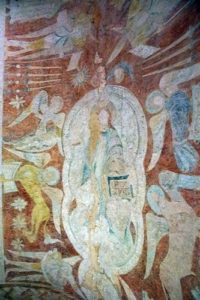This is a delightful small church built at the end of the C11th by Henry de Lacy, a favourite of Henry I, and major land owner, on the site of an earlier Saxon building. It maintains its Saxon layout with simple nave and chancel and a small square tower at the west end.
It is approached through a line of yew trees along the path. The timber frame south porch covers the original Norman doorway with chevron carving and a Tree of Life tympanum.
A step leads down into the church. This still has the original oak roof which is though to be the oldest in Britain. The trusses are held together by collar and struts. Carbon dating has shown the west door into the tower was felled between 1114-41.The parish chest under the tower is hollowed out from an elm log and dated 1492-1552. It was used to store villagers valuables.
At the back of the church is a Norman tub font.
There is a superb Norman chancel arch, still with its painting of red chevrons and red and white chequerboard pattern on the underside. The supporting pillars have lovely carved capitals.
People visit the church for its well preserved wall paintings. Those in the chancel are among the best in the country and give a feel for how colourful medieval churches must have been. These were commissioned by Huge de Lacy around 1120 as a memorial to his father Walter who fought in the Battle of Hastings. They were painted directly onto the damp plaster.
In the centre of the barrel ceiling is Christ in Majesty sitting on a rainbow with the sun, moon and stars around him. In his hand he holds a book. He is surrounded by the symbols of the four evangelists. On the walls are the twelve apostles , six on each side and set in arches. At the east end are the figures of two pilgrims with hats and staffs. It is suggested these may be images of Walter and his son Hugh. Above the side windows are representations of the Heavenly Jerusalem. To the south of the east window is a bishop holding a scapula. Above the window are roundels with angels holding scrolls.
The paintings in the nave are later, possibly C14th and were painted on dry lime mortar using an emulsified egg white. At the back of the north wall is St Christopher, although it is difficult to make out detail.
The wheel of Life is C15th and there is an information leaflet in the church explaining that Christ is in thee centre. Round the outside are ten images showing progression through life from a young child on his mother’s knee to death.
Next to the wheel of life is St Anthony of Egypt holding a book in one hand and a staff in the other. In the window splay is an image of the Virgin Mary.
On the south wall of the nave is the murder of Thomas a Becket, painted around 1370-80. The figures of the four knights are very clear. A kneeling Becket is on the left holding a crozier.
On the west wall are the remains of borders which once surrounded C16th texts. Above the chancel arch is the Easter Drama with the three Mary’s visiting the empty tomb with an angel to the left and a white cloth with stars over the tomb.
Stained glass windows contain C19th glass. The east window has the Virgin and Child with angels. The south chancel window has the Virgin Mary and Gabriel with God the Father above and a dove. The north window has St George killing the dragon.
This is a lovely little church and well worth finding. It is no longer used as the villagers moved to higher ground a couple of miles away. It is now in the care of the Churches Conservation Trust. The church is open daily and there is parking on the road outside.
There are more pictures “here.”:http://wasleys.org.uk/eleanor/churches/england/cotswolds/gloucestershire/gloucestershire_two/kempley/index.html








